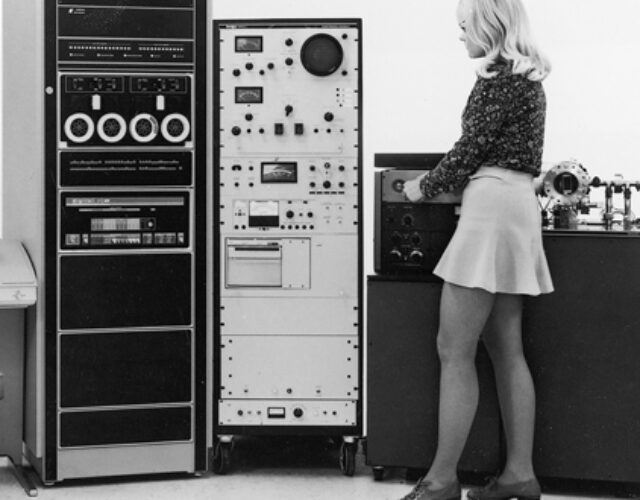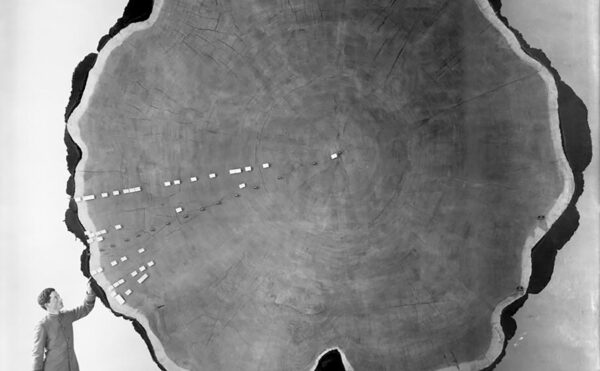In 1970 many Americans, dismayed by pollution in the air, water, and soil, participated in the first Earth Day and contributed to the political momentum that led to the creation of the Environmental Protection Agency (EPA). To protect the environment the EPA needed legislation, and to create legislation it needed the ability to precisely identify pollutants and measure their concentrations. Enter an unlikely entrepreneur, ex–cold war engineer Robert E. Finnigan.
Computers played an important role in waging the cold war. In the 1950s, at the Lawrence Livermore National Laboratory scientists and engineers used some of the most advanced digital computers of the time to design nuclear weapons. Finnigan, an Air Force officer with a PhD in electrical engineering, led a Livermore effort to develop a computerized control system for a nuclear reactor intended to power a thermonuclear missile that could prowl the skies for days. By 1962, though his team had successfully run a prototype reactor using a computer, Finnigan was convinced the missile program was doomed.
Finnigan and collaborator Mike Uthe wondered what they would do with their expertise in computer control of advanced nuclear reactors until the Stanford Research Institute (SRI) recruited them to start a controls group. At the time another team at SRI was developing quadrupole mass spectrometers, in which particular combinations of voltages are applied to four parallel rods, allowing selected ions to pass between them and reach a detector. Such an instrument can identify specific substances and measure their quantities. Finnigan and Uthe speculated that such a spectrometer would have broad applications.
Two years later Finnigan and Uthe joined Electronic Associates, Inc. (EAI), a leading U.S. supplier of analog computers, and continued working on quadruple mass spectrometers. The two wanted to contract the quadrupole research out to their former SRI colleagues but SRI shut down development, telling its researchers to buy the instruments rather than produce the devices themselves. However, no quadrupole mass spectrometer manufacturers existed, so Finnigan decided to become a commercial manufacturer, with SRI as his first customer.
Jack Jennings and Charles Rosen at SRI decided to simply give Finnigan what he needed to get into commercial production as quickly as possible: know-how and names. From 1964 to 1966 Finnigan and Uthe’s EAI division sold over 500 quadrupole residual gas-analyzer instruments. Researchers working in microelectronics and materials science were major consumers. With orders increasing, Finnigan and Uthe raised the price of their instruments, and their upstart division provided most of EAI’s profit.
While marketed as residual gas analyzers, the instruments that EAI produced from 1964 to 1966 were bona-fide mass spectrometers. They were not, however, adequate for the demanding analyses required in chemical research. Much would be required to transform them into analytical instruments. Finnigan became increasingly interested in the idea of a computer-controlled instrument in which a gas chromatograph (GC) would be used to separate the constituents of complex samples, and a robust quadrupole mass spectrometer (MS) would determine the nature and quantity of these constituents: a computerized GC/MS. With this idea Finnigan was developing a vision of the next phase of the instrumentation revolution in chemistry, a phase associated with the minicomputer revolution.
Finnigan’s start-up would quickly fail unless he convinced potential customers that it made sense to buy a new form of instrument with a dedicated computer. Enter the EPA.
The first minicomputers appeared in the early 1960s. These were refrigerator-sized digital computers that sold for tens of thousands of dollars. Laboratory scientists first used them to process the data from a single laboratory’s instruments. Palo Alto was home to several laboratories leading the application of GC/MS to biochemistry, including those of Carl Djerassi and Joshua Lederberg, who worked in pharmaceuticals and genetics, respectively. But making sense of the data produced in a single GC/MS run was extremely time-consuming. The measurement could be performed in a few hours, but organizing the data from a single run and then manually interpreting it could take weeks, even months. Both groups were looking at minicomputers as a solution to this glacially slow pace of data handling and interpretation. Their ultimate goal—real-time speed where data interpretation happens as a measurement takes place.
It was here that Finnigan saw a special advantage for the quadrupole mass spectrometer: its mode of operation made it particularly suited to control by a minicomputer. Finnigan believed a computerized GC/MS using quadrupole technology would provide both speed and power. When he failed to convince EAI to back an effort to develop such a product, he created a new organization to build the new instrument: the Finnigan Instrument Corporation, established in January 1967.
By early 1968 Finnigan’s company delivered prototype quadrupole GC/MS instruments to Lederberg’s Stanford lab and to the chemistry department at Purdue University. Within months the firm had introduced a fully computerized GC/MS. The instrument, with its advanced quadrupole mass spectrometer and customized minicomputer and software, cost $100,000. Despite its sophistication, power, and speed, only one order was delivered in 1969. Finnigan’s start-up would quickly fail unless he convinced potential customers that it made sense to buy a new form of instrument with a dedicated computer. Enter the EPA.
Scientists at the EPA had just begun an arduous process to determine which instruments and measurement methods would be used to construct and enforce pollution-control regulations. These instruments and methods would become the standard adopted by government, industry, and courts. Finnigan saw his future in a marriage between environmental regulation and his computerized GC/MS: it could rapidly and assuredly identify and quantify the organic compounds of greatest concern to the EPA. Following an intense courtship by Finnigan and his coworkers, in 1971 EPA scientists placed an order for 20 computerized GC/MS instruments for evaluation. This promising beginning blossomed after a 1975 article by an EPA scientist praised the computerized GC/MS for reducing thousands of man-hours to a single day’s work. Soon the EPA selected the computerized GC/MS as an approved way of measuring pollutants, and courts responded by accepting evidence from these instruments. Both government and industrial organizations bought and used the computerized GC/MS in rapidly increasing numbers in the 1980s.
By the 2000s computerized GC/MS instruments using quadrupole technology had become both essential to chemical research and one of the foremost instruments used for organic analysis. Today computerized GC/MS instruments are widely used in environmental monitoring of water, air, and soil; in the regulation of agriculture and food safety; and in the discovery and production of medicines. Looking back on the story of computerized GC/MS and quadrupole technology, Finnigan is still astonished by his unlikely journey from cold war military research to environmental protection.




